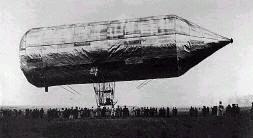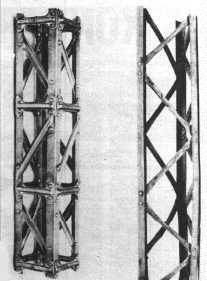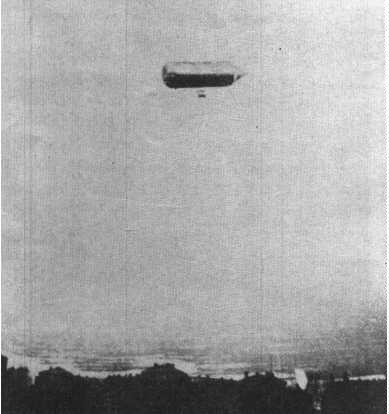The Construction and Testing of the Airship
David Schwarz (1852 - 1897) was a wood merchant from Zagreb, Croatia.
Although he did not have an official technical education, he still knew a lot
about mechanics and construction of airships as that was his hobby. He was
fortunate enough to realize his dream - the construction of the world's first
directable all-metal airship.
He made a contract about the construction of the airship with Carl
Berg, a German factory owner. All the parts for Schwarz's airship were made by
Berg's engineers and technicians in his factory, and in order to complete the
airship over thousand plans were made. During the construction Schwarz was
greatly assisted by major Hans Gross, who was an excellent balloon pilot. Just
like Schwarz, Gross was also very enthusiastic regarding the airship
project.
At that moment very little was known about the airship. The German
emperor Wilhelm II himself visited several times the hangar on Tempelhof field
near Berlin, where the parts produced in Berg's factory were put together. Carl
Berg invested large sums of money in this project, bearing in mind that he will
earn much more by building and selling airships. Schwarz also realized that the
eventual success of his airship would solve all his problems.
As he was aware of the basic laws of aerodynamics, Schwarz gave his
airship a pointed forward part. Journalists said that his airship resembled a
pencil, while military observers thought that the airship was shaped like an
artillery shell. Many people worldwide - balloon builders, engineers,
enthusiasts, scientists - were not merely interested, but amazed by the
construction of Schwarz's airship. Schwarz was indeed writing a new chapter in
the history of flying, and he had already proven some scientists to be wrong
when it came to the construction of his airship (a famous German physicist
Hermann von Helnholz (1821 - 1894) insisted that airships should not be built
out of metal as they would be too heavy to fly.
 Schwarz's airship after completion
Schwarz's airship after completion
It is interesting that very little was written about Schwarz and his
airship in Croatian newspapers of that period. Agramer Tagblatt has not
even mentioned him, while a small article appeared in Zagreb daily newspaper
Obzor on September 11th 1896. This is the complete text of the
article: "The day before yesterday we received a telegram sent by an
amateur journalist. He informed us that David Schwarz from Zagreb has invented
an airship which he hopes he could direct on his own free will. The inventor is
now finishing his airship on Tempelhof field near Berlin. The huge airship is
built out of aluminium alloy, the composition of which is being kept secret by
the inventor. The first test with that airship will be carried out on 27th of
this month, when the German general staff returns from the inspection trip to
Vienna."
This was the first news in Croatia about the project of David
Schwarz.
The German government was very interested in the invention of David
Schwarz. It is interesting to point out that the same German government only
two years before refused the idea of its own general Ferdinand von Zeppelin,
about the construction of a directable airship. One has to bear in mind,
though, that Zeppelin's ideas were just theoretical, while Schwarz made
detailed plans of the airship. As Zeppelin had no knowledge to create similar
plans of his own airship, he was not only interested in Schwarz's airship, but
he also wanted to cooperate with him. Schwarz refused any kind of
cooperation.
 Latticed props from Schwarz's airship
Latticed props from Schwarz's airship
The airship was completed in summer 1896, and was ready for testing.
However, Schwarz was hesitating mostly due to health problems - he had a weak
heart. Also, he was expecting the emperor Wilhelm II to attend the official
public flight that was supposed to take place on September 27th. The emperor
could not come and the flight was cancelled. Schwarz would not wait any longer.
He wanted to test his creation.
Finally, on October 8th 1896 the process of filling the airship with
hydrogen began. The quality of hydrogen was not satisfactory. This meant that
the expected lift force of 1.15 kN per square metre could not be achieved. The
airship was taken out of the hangar in which it was put together. Dozens of
soldiers were holding steel cables which were tied on every side of the airship
in order to prevent the airship from lifting before the airship's engine
started working. The engine was thoroughly tested and it proved not to be only
reliable, but also strong enough to move the airship.
The test is described in an article in Obzor: "Yesterday,
on Thursday, October 8th 1896, Schwarz's airship managed to lift only a few
metres above the ground, while the soldiers were holding it with ropes. It is
said that the gas used in the airship was bad, and thus the airship could not
perform as expected. It was decided that the airship would be filled once again
with good gas and tested."
It was an unforgettable day for Schwarz. All humiliations, sufferings
and harassment that he experienced previously were defeated. True, the airship
lifted only a few metres, but the engines were working perfectly and the
propellers were turning as they were supposed to. This meant that the airship
could be directed on one's free will. It was no longer a balloon carried by wind
without the control of a few people carried in a basket. It was a directable
airship.
After that test Schwarz was very excited. He had many ideas about how
to use airships; he created a vision of air traffic. Airships would, he
thought, become faster and stronger, transporting passengers, mail, many
different sorts of cargo across vast distances in short time. Hours, not days,
would be needed to reach distant continents.
 The four - cylinder, 16 hp Daimler engine of Schwarz's
airship
The four - cylinder, 16 hp Daimler engine of Schwarz's
airship
It was arranged that the inventor himself would prove the value of
his project on January 15th 1897. Schwarz left Zagreb on January 12th and
headed for Berlin. When he was leaving he said to his wife and children:
"They do not believe me, but they will after I die." He spent the first
night in Vienna. On January 13th he sent a telegram to his wife saying: "I am
well, and tomorrow I will arrive in Berlin. The flight is the day after
tomorrow." He also sent a telegram to Berlin: "I am arriving tomorrow.
Please start filling the airship with hydrogen." He was very happy and very
excited. He could hardly wait to continue his trip to Berlin. Around noon he
and some of his friends went for lunch to one of the most famous restaurants in
Vienna, Zur Linde. After a few spoons of soup he started feeling nausea
and dizziness. "I do not know what is wrong with me... I feel sick as I have
never felt before.", he said to his friend. The friend advised him to go
outside and breathe some fresh air. As soon as Schwarz entered the hall of the
restaurant, he leaned against the wall with his hands and, after a minute,
collapsed and died. He was 45 years old.
The Austrian Society of engineers and technicians buried David
Schwarz in a honorary tomb with a nice headstone on the central Wien cemetery.
The Universities of Berlin and Wien awarded him posthumously with the title of
honorary engineer. Despite all this his name will soon disappear from the
history of mankind.
The German general staff and the Society for aerial navigation
continued to show interest in Schwarz's airship. When Schwarz was making a
contract with the German government about the construction of the airship, it
was also agreed that Schwarz would have an exclusive right to build airships
for the next 30 years. There were many people who were pleased by Schwarz
sudden death. Among these were certainly Germans who could not believe how much
care and honour was given to this Croatian wood merchant, and who, therefore,
tried to erase Schwarz's name from the history of technological development.
This was one of the reasons why the German government not only wanted to get
rid of the contract which now existed between the government and Schwarz's
heirs, but also started to favour count Ferdinand von Zeppelin, whose ideas
were until Schwarz's death constantly refused by the same government. Zeppelin
was, of course, very pleased with the new situation. He possessed enough
technical information about Schwarz's airship, which he obtained illegally from
the factory of Carl Berg. Nobody can deny Zeppelin's enthusiasm and wish to
build a similar airship. But, if we take in consideration Zeppelin's education
and the fact that he knew very little about technical sciences, then it is
obvious that he could have been only an organizer and an advocate of the usage
of airships. Schwarz was, on the other hand, although he did not have an
official technical education, so educated in this sense, that his ideas were
worked out in detail by technicians and engineers during the construction of
the airship.
The German army was aware that airship is a new kind of weapon. It
could be used for reconnaissance, troop transport, bombing. Apart from that,
German colonies in Africa were full of raw materials which would enable the
construction of many such airships.
 Schwarz's airship flying 400 metres above Tempelhof field during
its trial flight
Schwarz's airship flying 400 metres above Tempelhof field during
its trial flight
Schwarz died before he could see his airship flying properly.
Nevertheless, his wife Melanie, an energetic and wise woman, went to Berlin
just after the funeral to continue the work of her husband. She was trying to
organise a trial flight. The flight was supposed to show and prove the value of
the airship. However, she encountered numerous problems. The German military
circles were annoyed by the fact that the airship was not of German origin, and
they were trying to sabotage Melanie Schwarz's efforts whenever possible.
Still, the trial flight was carried out. The German emperor wanted to be
present during the trial flight of the airship, but he had to attend a meeting
with the Austrian emperor Franz Joseph I. The trial flight took place above
Tempelhof field. The airship performed as expected. However, when the airship
was flying at the height of 460 metres one of the propellers stopped working,
because its driving belt fell down. The airship crashed and was severely
damaged. Still, the German Ministry of army gave flattering acknowledgements
in its official opinion about Schwarz's airship. The same opinion was repeated
on September 30th 1908 in the magazine Neue Freie Presse. Despite all
this, not one German officer was allowed to steer the airship during its trial
flight. Why? It was an order. Clearly, someone in the German army did not want
the trial flight to take place. After the trial flight Zeppelin gave Melanie
Schwarz 15, 000 Marks in order to obtain some information about the airship and
to continue using the information that he already possessed.
The testing of the airship which took place on October 8th 1896. was
carried out without the presence of the public. This proved to be Schwarz's big
mistake. If the public had been present, then nobody would have been able to
cover up and belittle Schwarz's invention or even, later, deny its precedence
and originality.
Technical Characteristics of Schwarz's Airship
 Homepage
Homepage
Copyright � 1998 - 2004 Ante Sucur


